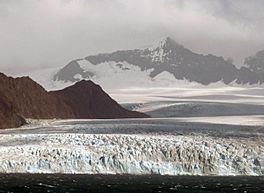Fortuna Glacier facts for kids
Quick facts for kids Fortuna Glacier |
|
|---|---|
| Glaciar Fortuna | |

Fortuna Glacier
|
|
| Location | South Georgia |
| Coordinates | 54°6′S 36°51′W / 54.100°S 36.850°W |
| Thickness | unknown |
| Terminus | Fortuna Bay |
| Status | unknown |
Fortuna Glacier is a giant river of ice found on the island of South Georgia. It's a tidewater glacier, which means it flows directly into the ocean. The glacier moves towards the northeast, ending near a place called Fortuna Bay. It was given its name around 1912, likely after a ship called Fortuna that was used for whale hunting. This glacier is famous for two important historical events that happened in the 20th century.
Contents
Ernest Shackleton's Amazing Journey in 1916
Shipwreck and Stranding
In April 1915, the famous explorer Ernest Shackleton was on an expedition to Antarctica. His ship, the Endurance, got stuck in thick ice in the Weddell Sea. The ship was trapped for many months.
By the spring of 1916, the ice started to melt and break apart. Sadly, Shackleton's ship was crushed by the ice. The 27 members of his team had to use lifeboats to escape. They managed to reach Elephant Island, a very remote and empty island near the Antarctic Peninsula. They were completely stranded there.
A Dangerous Rescue Mission
Shackleton knew they needed help. He and five other men bravely set off in a small lifeboat called the James Caird. They sailed an incredible 800 miles (1,300 km) across the stormy Scotia Sea. After two weeks, they finally reached South Georgia.
They landed on the island's wild, uninhabited west side at King Haakon Bay. Bad weather made it impossible to sail further to the whaling stations. These stations were the only places where people lived on the island.
Crossing South Georgia's Interior
Instead of sailing, Shackleton and two of his men decided to cross the island on foot. This was a very difficult journey because the island's interior was mostly unknown. They had to trek over mountains and glaciers.
One of the glaciers they crossed was the Fortuna Glacier. After 36 hours of non-stop travel, they finally reached the Stromness whaling station. This incredible journey is one of the most famous survival stories in history.
The Falklands War and a Daring Rescue in 1982
Recapturing South Georgia
In 1982, Argentina took control of the Falkland Islands and South Georgia. The British military launched an operation called 'Operation Paraquet' to take the islands back. Their goal was to remove the Argentinian forces and return the island to British control.
Landing on the Glacier
As part of this plan, British forces decided to land a special mountain troop on Fortuna Glacier. This group included soldiers from the Special Air Service and 42 Royal Marine Commandos. The idea was to approach Grytviken from a direction the Argentinians would not expect.
On April 21, the troops were dropped onto the glacier. The weather was extremely bad, with very poor visibility and strong winds. Conditions quickly got even worse.
Helicopter Crash and Rescue
The next day, several helicopters tried to rescue the stranded troops. A Wessex 3 helicopter from HMS Antrim and two Wessex V helicopters from HMS Tidespring were involved. During these rescue attempts, the two Wessex V aircraft crashed due to the extreme weather.
However, the Wessex 3 helicopter, piloted by Lieutenant Commander Ian Stanley and his crew, managed an amazing rescue. They successfully picked up all the troops and aircrew from the crashed helicopters. This incredible feat of flying and navigation happened just before dark.
When the Wessex 3 returned to HMS Antrim, it was carrying 16 people. This was far more than its normal capacity of only 4! This brave helicopter can now be seen at the Fleet Air Arm Museum in Yeovilton, Somerset.
Images for kids
See also
 In Spanish: Glaciar Fortuna para niños
In Spanish: Glaciar Fortuna para niños



